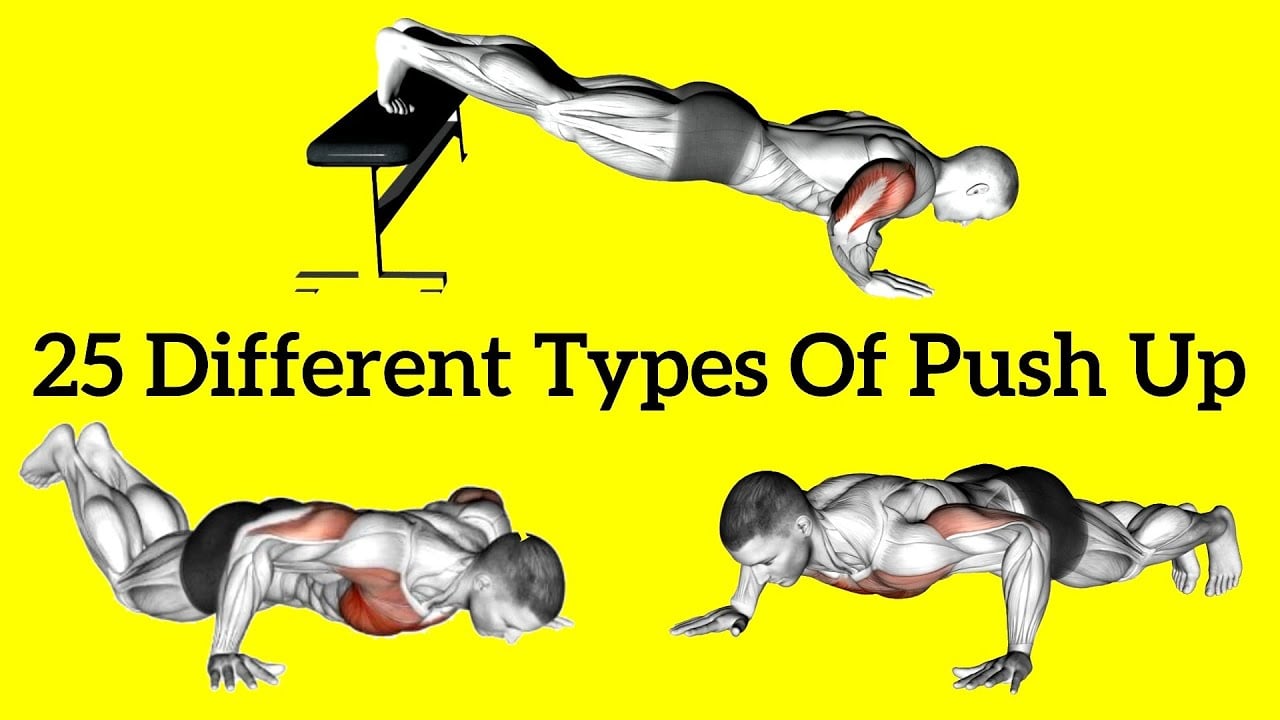Are you stuck on a push-up plateau? It happens to everyone, and doing the same exercise daily can lead to stalled progress.
Your body quickly adapts to the same stimulus, which means standard push-ups eventually stop delivering results.
Sometimes, we have many confusing questions about push-ups. For instance, which type of push-up suits beginners, intermediates, and advanced individuals?
Which variations target the upper, lower, and inner chest, triceps, and shoulders best?
That’s why I’ve compiled these 25 push-up variations that target different muscle groups, challenge your stability, and introduce new growth stimuli.
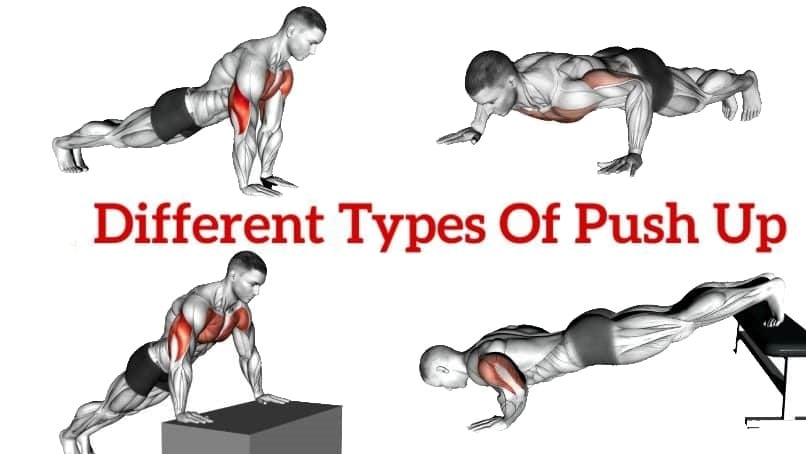
- Biomechanics of Different Push-Ups Variations
- 25 Best Push Ups Variations And Types
- 1. Wall Push Up
- 2. Incline Push up
- 3. Knee Push Up
- 4. Standard Push-Ups
- 5. Knuckle push up
- 6. Decline Push Up
- 7. Wide Push Up
- 8. Dumbbell Push Up
- 9. Close Grip Push Up
- 10. Diamond Push up
- 11. Spiderman Push Up
- 12. Shoulder Tap Push Up
- 13. Hindu Push Up
- 14. Fingertip Push up
- 15. Single Leg Push Up
- 16. One Arm Push Up
- 17. Reverse Grip Push Up
- 18. Archer Push Up
- 19. Pike Push Up
- 20. Clapping Push up
- 21. Medicine Ball Push Up
- 22. Feet On Stability Ball Push-Up
- 23. Renegade Row Push Ups
- 24. T Push Up
- 25. Superman Push Up
- How To Add A Different Type Of Push up To Your Workout?
- FAQs
- Which push-up variation is the best?
- What pushups are easiest?
- Which is the hardest push-up?
- How long does it take to see results from doing push-ups?
- Reference
Biomechanics of Different Push-Ups Variations
Push-ups can be performed with many variations to create different muscular recruitment patterns.
Many biomechanical variations of the push-up exercise can alter muscle activity by providing a lesser or greater challenge to the target musculature.
These different types of push-ups often involve altering hand and foot positions, impacting muscle recruitment patterns. That’s why some push-ups focus primarily on the chest, some on the triceps, and others on the shoulders.
Several potential hand positions exist; the most common classifications include:
- Wide base (150% shoulder width)
- Normal base (shoulder width), and
- Narrow base (50% shoulder width)
The wide base activates the pectoralis major to a greater degree than the other positions, whereas the narrow base optimizes the activation of the triceps brachii.
There are many ways to do push-ups, including different foot positions and angles. The most common ones are:
Because of the angle, the Incline push-up works your lower chest and core more. On the other hand, the decline push-up works the upper chest and front shoulders (delts) more than the regular or incline variation.
These different types of push-ups can be used in fitness settings to vary the program and offer a range of low- to high-intensity options.
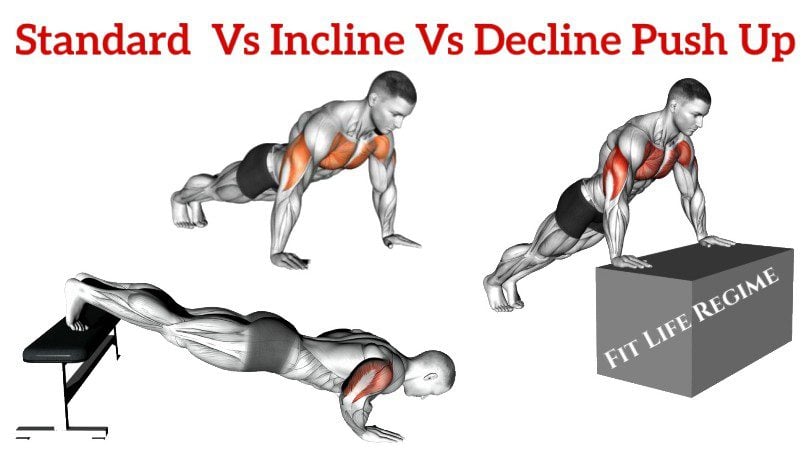
Know More: Standard Push Up Vs Incline Push Up Vs Decline Push Up
25 Best Push Ups Variations And Types
Here are the best push-up variations for beginners, intermediates, and advanced practitioners to build a strong upper body. Focus on proper form and positioning.
1. Wall Push Up
The wall push-up is a simple push-up that dramatically reduces the pressure on the arms, upper back, and abs.
The closer you stand to the wall, the easier it is to perform, but remember to be aware of your body alignment as you perform this push-up.
I’ve used wall push-ups with clients new to exercise, and it’s amazing how quickly they build confidence and strength before progressing to the floor.
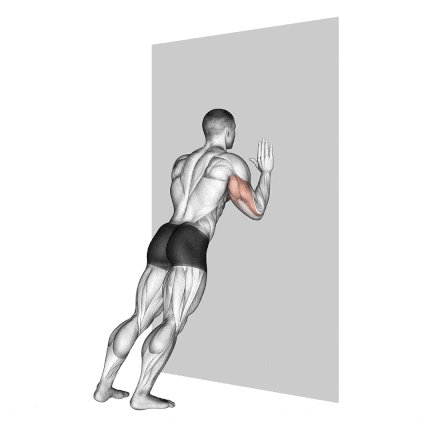
How To Do
- Stand approximately 2 to 2.5 feet away from the wall, arms held at shoulder height in front of you.
- Place your hands against the wall, your body straight, and your legs a few feet behind you so that your body draws a triangle together with the wall and the floor.
- Keep your feet fixed to the ground and lean your body forward so that your elbows flex and your chest is within the wall.
- Press through your hands to push your body back to the starting position.
2. Incline Push up
Incline push-ups serve as a stepping stone for those new to push-ups or with limited upper body strength.
This variation is performed with your hands on a bench, box, or sturdy chair or any elevated surface.
Incline push-ups still target the chest, shoulders, and triceps like standard push-ups, but with a greater emphasis on the lower chest and shoulders.
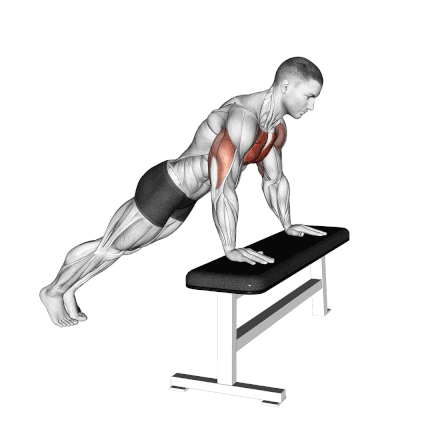
How To Do
- Choose a stable surface like a bench, box, or sturdy chair. The higher the surface, the easier the push-up. Start with a lower incline and gradually increase it as you get stronger.
- Place your hands on the elevated surface, slightly wider than shoulder-width apart.
- Step back until your body forms a straight line from your head to your heels. Engage your core to prevent sagging.
- Bend your elbows and lower your chest toward the surface while maintaining a straight body line.
- Press through your palms and extend your arms to return to the starting position.
3. Knee Push Up
The Knee Push-Up is a fantastic modification that allows you to build strength and master the correct form without using your full-body weight.
Get down on your hands and knees. Position your hands slightly wider than shoulder-width apart, with your fingers pointing forward.
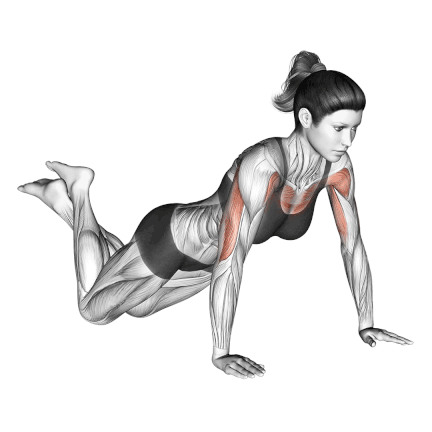
How to do
- Get down on your hands and knees. Position your hands slightly wider than shoulder-width apart.
- Lower yourself by flexing your elbows so that your chest comes within a few inches of the floor, making sure your body is straight from your head to your knees.
- Raise your body to the starting position by pushing up with your arms.
- Start with 8–12 repetitions for 2–3 sets, and then slowly increase reps and sets.
4. Standard Push-Ups
The Standard Push-Up is a popular variation of push-ups that builds your entire upper body, shoulders, chest, and arms. It also engages the core, back, and lower body muscles for a full-body workout.
Throughout my training, I’ve witnessed many people transform their bodies and build strength by mastering the standard push-up.
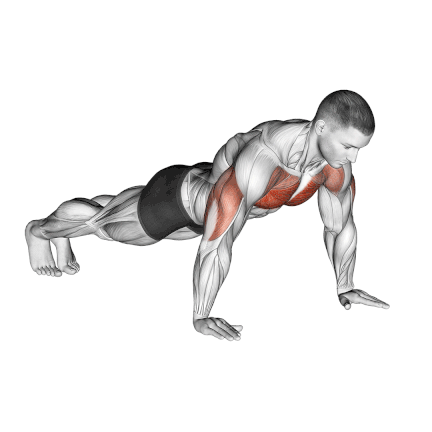
How to do
- Start in a high plank position with your hands slightly wider than shoulder-width apart.
- Engage your core, squeeze your glutes, and maintain a neutral spine.
- Lower your body towards the ground by bending your elbows while keeping them close to your sides.
- Pause for a moment at the bottom position.
- Return to the starting position by pushing through your palms and straightening your arms.
5. Knuckle push up
Knuckle push-ups are a variation of the standard push-up where you perform the exercise on your knuckles instead of with your palms flat on the ground.
During Knuckle Push-Ups, the pressure is placed on your knuckles instead of your extended wrists.
If you experience wrist pain while doing standard push-ups, doing Push-Ups on your knuckles may be a good way to get the benefits without the wrist pain.
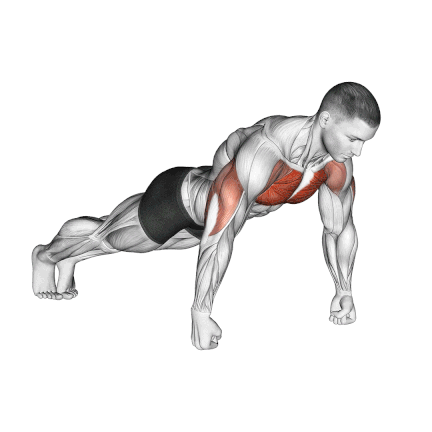
How to do
- Assume a standard push-up position, but place your fists’ knuckles on the floor perpendicular to your body.
- Perform a traditional push-up by keeping your body straight while pushing yourself up, until your arms are fully extended.
- Slowly lower yourself back down to the starting position.
6. Decline Push Up
Decline Push-ups are similar to normal push-ups but with your legs on a bench. Although this is called the Decline push-up, it focuses more on the upper pecs.
Furthermore, your lower body is raised from the floor, and your body’s resistance is increased compared to doing the push-up on the floor. The decline type of push-up is harder than the standard push-up.
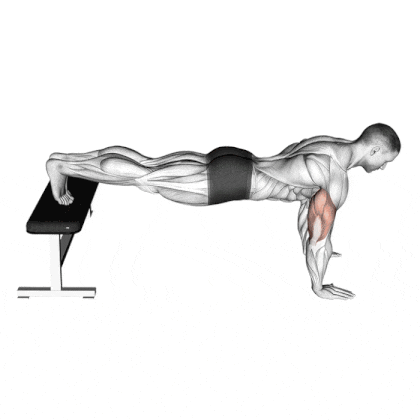
How to do
- Placed your hands firmly on the floor and spaced slightly wider than shoulder-width apart. Put legs on the bench or the pad roller.
- Now, raise yourself off the ground, straightening your elbows and your arms. Keep your elbows close to your body.
- Raise until your elbows are almost near to locked, and pause for a moment at the top of the movement.
- Now lower your body slowly and sustainably, feeling the motion all the way down until your chest is very close to the ground.
Read More: Best Push Ups For Upper Chest To Build Size And Strength
7. Wide Push Up
Wide push-ups vary from the standard push-up where your hands are positioned wider than shoulder-width apart.
This variation targets the chest muscles (pectoralis major) more extensively while still engaging the shoulders, triceps, and core. The wider hand placement helps to strengthen the outer chest muscles, resulting in a broader and more defined chest.
If you’ve mastered regular pushups and want to target your muscles differently, wide pushups are a good option.
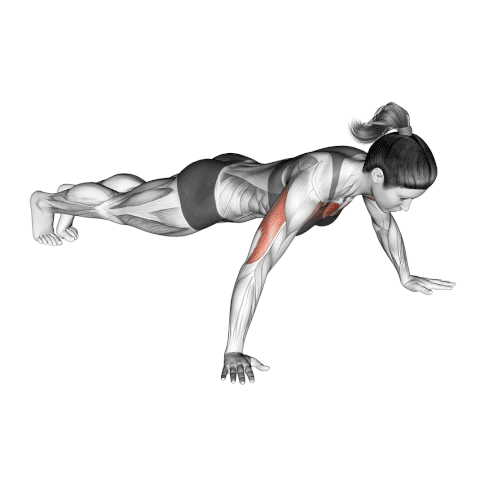
How to do
- Lay face down on the ground with your legs straight and arms supporting your upper body.
- Put your arms in the 90/90 push-up position.
- Slowly descend to the floor by retracting the shoulder blades and unlocking the elbows.
- Descend until the upper arms are parallel or your chest touches the floor.
- Push back to the starting point by extending the elbows and driving your palms into the floor.
8. Dumbbell Push Up
Dumbbell push-ups are a fun twist on the classic move. Dumbbells increase the intensity and give you a better range of motion. They let you lower your body further for a deeper stretch and improve muscle activation.
In my experience, dumbbell push-ups are a fantastic tool for advanced trainees looking to push their limits.
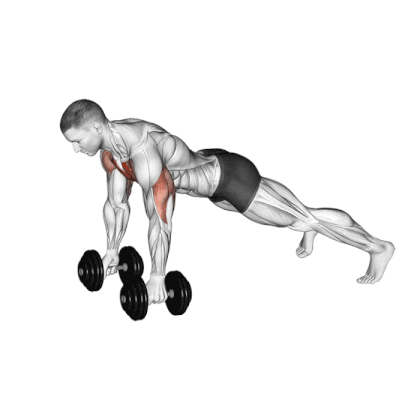
How to do
- Place two dumbbells parallel to each other on the ground, slightly wider than shoulder-width apart.
- Engage your core, squeeze your glutes, and maintain a straight line from head to heels.
- Lower your body towards the ground by bending your elbows, keeping them close to your sides.
- Try to bring your chest close to the ground without touching it, but keep your posture correct.
- Pause for a moment at the bottom position.
- Then, push through the dumbbells, straighten your arms, and return to the starting position.
9. Close Grip Push Up
Close-hand push-ups, often referred to as narrow-grip push-ups, involve positioning the hands close to each other. Because of the narrower base of support, they are one of the more challenging variations of the push-up.
This workout makes your triceps work harder because you hold your hands closer together, which makes them work harder.
This is evidenced by a study that found greater electromyography (EMG) activity in the triceps brachii during close push-ups than during regular push-ups.
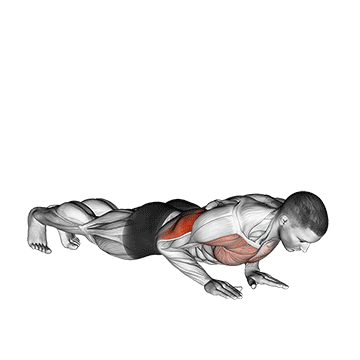
How to do
- Make your push-up position narrower than usual.
- Now, raise yourself off the ground, straightening your elbows and arms, keeping your elbows close to your body.
- Raise until your elbows are locked and then pause for a moment at the top of the movement.
- Now, slowly and steadily lower your body until your chest is close to the ground.
Read More: Close Grip Push Up: How To Do, Muscle Worked, Benefits
10. Diamond Push up
Diamond push-ups, also known as triangle push-ups, are a more advanced type of the classic push-up. You can practice diamond push-ups by bringing your hands too close together to form a diamond or triangle shape below your chest.
Adding the diamond push-up to your workout routine can provide several benefits. These include an increase in triceps and chest activity, improvement in core strength and stability, and enhancement of shoulder strength.
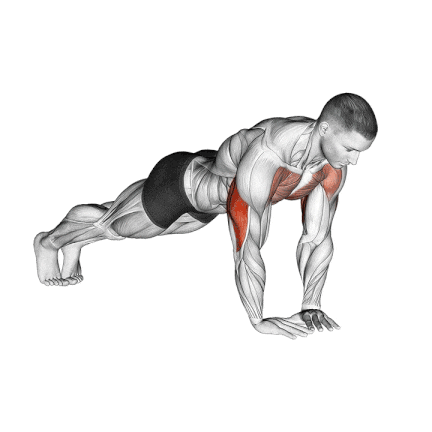
How to do
- Get on all fours with your hands together under your chest.
- Position your index fingers and thumbs so they’re touching, forming a diamond shape, and
- Then extend your arms to elevate your body and form a straight line from your head to your feet.
- Stop before your chest touches the floor, then push back up to the starting position.
11. Spiderman Push Up
The Spider-Man Push-up is a good alternative to the standard push-up if you’re tired of it and need a challenge. This exercise primarily strengthens the chest and arms, but it also increases hip flexibility and really works your core.
In a Spider-Man push-up, the performer brings one knee to the elbow, creating a dynamic movement that challenges the core and improves stability. It also engages the shoulders and back muscles, making it a full-body exercise.
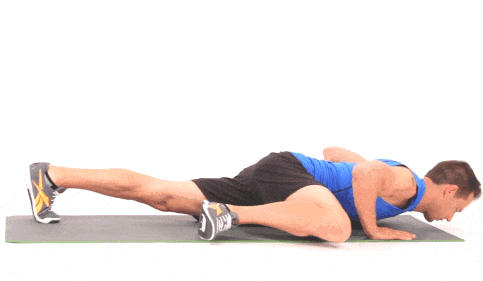
How to do
- Start in a high plank position, hands flat on the floor about shoulder-width apart, wrists under shoulders.
- Keeping your body in one long line, bend your arms and lower yourself as close to the floor as possible.
- As you lower your body, bend one leg out to the side and bring your knee toward the arm on the same side.
- Push back up to start, and straighten your leg back out. Repeat alternating sides.
12. Shoulder Tap Push Up
The shoulder tap push-up is a variation of the push-up that challenges the core more than its traditional counterpart.
Once you can do at least 10 full push-ups, you should be able to start incorporating some shoulder taps into the mix.
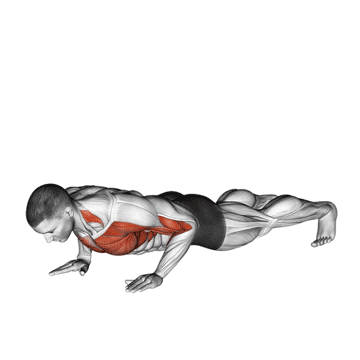
How to do
- Get in the standard push-up position
- Lower yourself by flexing your elbows so your chest comes within a few inches of the floor.
- Raise your body to the starting position by pushing up with your arms. Tap your left hand to your right shoulder while engaging your core and glutes to keep your hips as still as possible.
- Place it back on the floor and repeat your next push-up and shoulder tap with another hand.
13. Hindu Push Up
Unlike conventional push-ups, Hindu push-ups don’t concentrate heavily on the chest muscle. Instead, they are an incredible exercise for developing stronger shoulders, pectorals, arms, core, and spine.
Hindu push-ups are a combination of two strong yoga poses, upward-facing dog position and downward dog-facing position, which give remarkable results in spine mobility and flexibility.
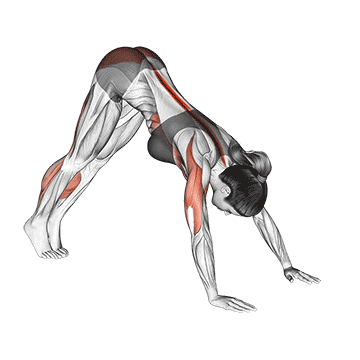
How to do
- Start in a downward dog pose, with your hands shoulder-width apart, your body in a V shape, and your feet hip-width apart.
- Bend your elbows and lower your chest until it’s just above the floor, going into a low plank pose.
- In a scooping motion, lift your head upward while arching your lower and upper back, then go into cobra pose.
- Push your hips back up into the starting position to return to the starting position.
14. Fingertip Push up
Doing push-ups on your fingertips can look impressive, and it’s also an efficient exercise to increase your grip for basketball, bodybuilding, or rock climbing.
It also keeps your wrists straight, making it an excellent way to eliminate wrist pain from the 90-degree bend when your palms are flat on the floor.
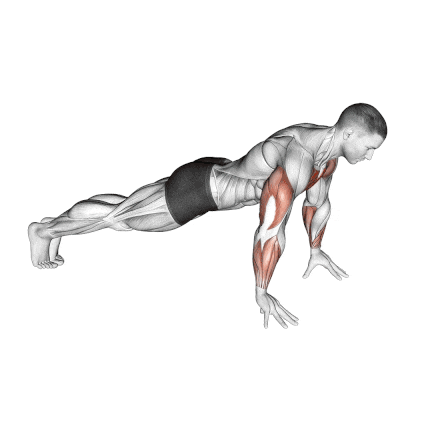
How to do
- Get into a standard push-up position, but instead of placing your palms flat on the ground, position your fingertips on the floor. Your fingers should be spread wide for better balance.
- Slowly bend your elbows, lowering your chest towards the ground while keeping your fingertips in contact with the floor.
- Breathe out as you push yourself up using your arms.
- Then, Push through your fingertips to raise your body back to the starting position.
15. Single Leg Push Up
Single-leg push-ups are an advanced variation of the traditional push-up that introduces an additional balance challenge by lifting one leg off the ground.
From my experience, single-leg push-ups are a fantastic way to assess and improve core stability. I’ve used them as a progression for advanced clients who are looking to push their limits and take their core strength to the next level
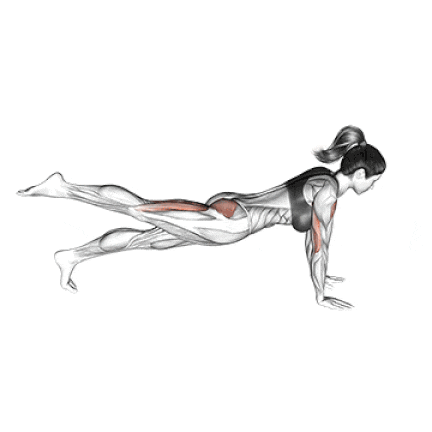
How to do
- Take the standard push-up position, but place one foot on top of the other or one place one foot in the air straight behind you.
- Lower yourself by flexing your elbows so that your chest comes within a few inches of the floor.
- Make sure your body is in a straight line from your head to your toe and you one leg in the air.
- Raise your body to the starting position by pushing up with your arms.
- Repeat the desired number of repetitions.
- Make sure to alternate legs in between sets or repetitions to create a symmetrical body.
16. One Arm Push Up
A one-arm push-up is a compound exercise that requires far more strength and balance than a standard push-up using two arms. This variation allows you to train unilaterally (one side of your body at a time), which is typically an option with traditional pushups.
It just might be one of the most difficult body-weight exercises to master.
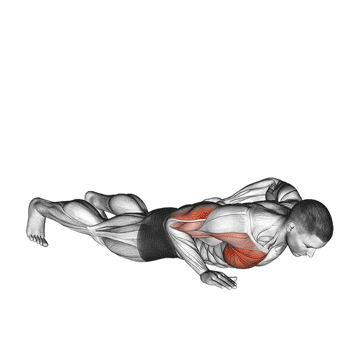
How to do
- Get in the standard push-up position.
- Place one hand on the ground directly beneath your chest and the other behind your lower back.
- To maintain balance, turn your torso slightly away from the pushing arm.
- Breathe in as you lower your angled torso to the ground until your chin is a few inches above the floor.
- Breathe out as you push yourself up from the floor. Stop just before you lock out your elbow at the top of the movement.
17. Reverse Grip Push Up
The reverse grip push-up is a fun and great variation on the standard push-up. It is done with your fingers facing your feet (your palms outward). Many consider it the “bicep push-up” because of the hand position; it emphasizes your biceps a little more than the standard push-up.
For an easier variation, you can do the Reverse Grip Push-Ups on the knee or on an inclined surface.
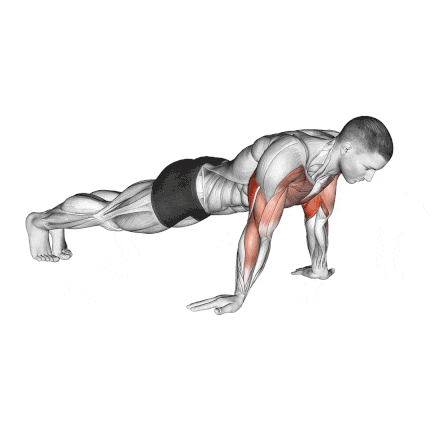
How To Do
- Start in a standard push-up position. Place your hands slightly wider than your shoulders, palms flat on the floor, and fingers pointing towards your feet.
- Inhale and slowly start to bend your elbows. Do not let your elbows move outwards (away from your body).
- Lower yourself until you are about an inch from the floor.
- Pause the movement when you are at the bottom for a second.
- Push through your palms like you would try to push the floor away from yourself.
- Finish the exercise by extending your arms completely out.
18. Archer Push Up
In Archer push-ups, the arms are kept wider than in the normal push-up position.
As you lower your body, you transfer the majority of your weight to one of your hands and incline towards that hand while the other hand is kept straight. Simultaneously, move your body to both sides.
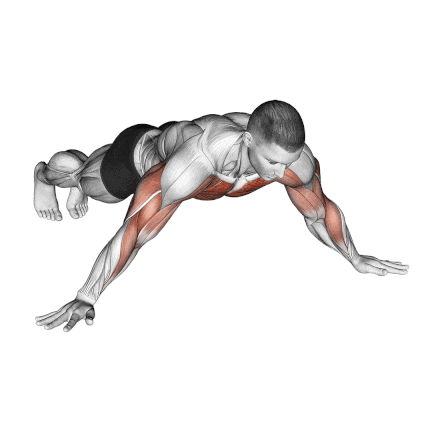
How to do
- Start in a standard push-up position.
- Maintain a strong core position and shift your upper body toward your right side.
- Pull your right chest toward your right hand as you bend your right elbow.
- As you lower toward the right side, allow your left arm to straighten.
- Your left arm should be fully extended, forming a straight line from your shoulder to your hand.
19. Pike Push Up
Pike Push-ups are a type of push-up that increases strength and stability in the shoulders and triceps. Performing the exercise in a more upright position targets the shoulders more than the chest.
The inverted position of the pike push-up can help to stretch and lengthen the muscles in the shoulders and upper back, increasing flexibility in these areas.
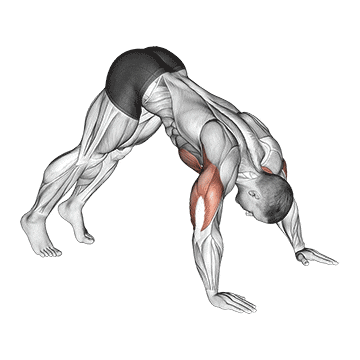
How to do
- Start in a standard push-up position.
- Lift the hips up and back until your body forms an inverted V shape. Keep arms and legs as straight as possible.
- Slowly lower the top of your head towards the ground. Once your head is about to contact the ground, pause for a second.
- Then slowly push back until your arms are straight, and you’re in the inverted V position.
Read More: 5 Best Shoulder Push-Ups To Build Strength & Mass
20. Clapping Push up
Clapping Push-ups is an advanced variation of push-up exercise that works your chest, triceps, abs, and shoulders.
It can help burn fat and build muscle. Many athletes perform them to help improve their athletic performance by building strength, endurance, and speed.
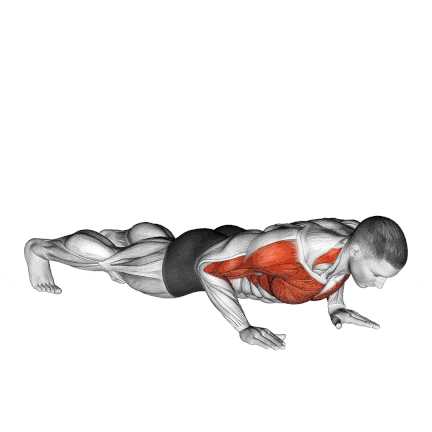
How to do
- Start with a standard Push-Ups.
- Start to lower your body as if you’re going to do a push until your chest is almost touching the floor.
- Reverse the motion by pushing hard through the palms, just as your arms reach full extension, pull your hands up off the floor.
- Rapidly clapping the hands together and placing them back in the original position before your body falls back to the ground.
21. Medicine Ball Push Up
The Medicine Ball Push-Up is a more challenging variation compared to standard close-grip push-ups.
Research shows that push-ups on unstable surfaces increase triceps activation compared to stable surfaces. With your hands on a medicine ball, your triceps work harder to stabilize and control the movement.
With the medicine ball variation, your stabilizer muscles, such as the anterior deltoid, get a workout, promoting better shoulder stability.
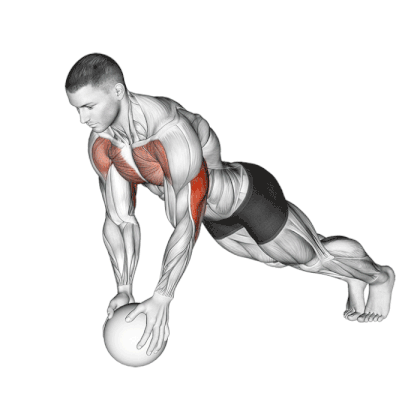
How To Do
- Get in the standard push-up position with your hands on a medicine ball directly beneath your chest.
- Your left thumb and forefinger should touch your right thumb and forefinger.
- Bend your elbows to lower yourself in a controlled manner.
- Maintain a rigid core as your chest moves towards the top of the ball.
- Hold for one to two seconds before breathing out. Extend your arms and push your body back to the starting position.
22. Feet On Stability Ball Push-Up
The push-up with feet on a Swiss ball is a progression of the decline push-up that targets the upper chest, shoulders, and triceps while engaging the core.
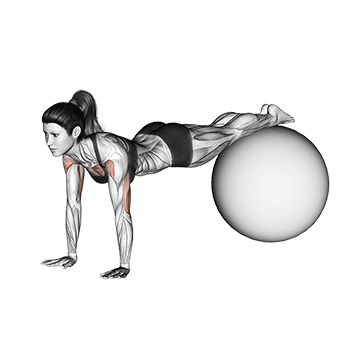
How To Do
- Lie face-down on the ball with your arms supporting you in push-up position.
- Roll forward until your pelvis and thighs are off the ball, and position your feet on top of the ball.
- Your hands should be directly beneath your shoulders.
- Breathe in as you lower yourself by bending your arms until your elbows form a 90-degree angle.
- Pause for one to two seconds at the bottom before breathing out and using your arms to push you up to the starting position.
23. Renegade Row Push Ups
Renegade Row Push Ups is a full-body exercise that combines a push-up with a row using dumbbells or other weights. It targets the chest, shoulders, triceps, and back muscles, as well as the core.
One of the main benefits of the renegade row push up is that it provides a greater challenge to your core, since you need to maintain stability throughout the movement.
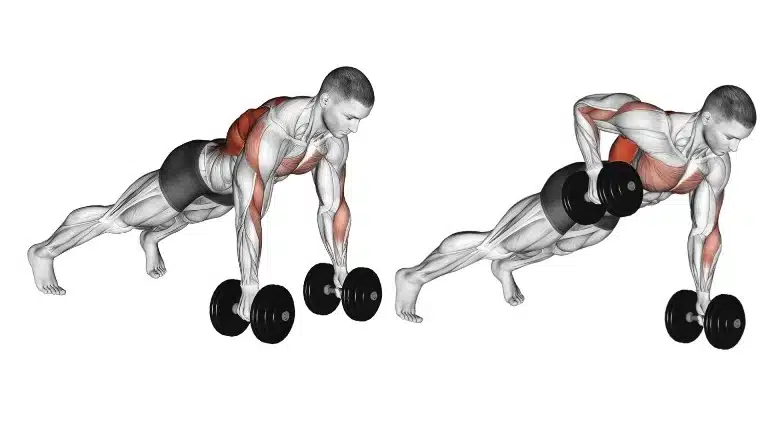
How To Do
- Begin in a plank position with your hands on the floor and slightly wider than shoulder-width apart.
- Brace your abs, squeeze your glutes and keep your core tight throughout the exercise.
- Keeping your body straight and rigid, begin to lower yourself towards the floor into a push up.
- As you push back up to the starting position, lift one arm and bring your elbow up to the side of your body, squeezing your shoulder blade toward your spine.
- Lower the weight back down.
- Once you have finished with one side, repeat the motion with the other arm, maintaining a strong core throughout.
- To complete one full rep of the Renegade Row Push Up, repeat these steps for both sides.
24. T Push Up
T push-up is a variation of the traditional push-up that adds a rotational movement. It is a compound exercise that primarily targets the chest, shoulders, and triceps.
The exercise is performed in a similar fashion to a traditional push-up. However, with an additional movement, one arm is lifted and rotated out to the side, forming a “T” shape with the body.

How To Do
- Start in a traditional push-up position with your hands placed slightly wider than shoulder-width apart and your feet together.
- Lower your body towards the ground, keeping your core engaged and your back straight.
- As you reach the bottom of the push-up, lift one arm off the ground and rotate your body so that your arm is pointing straight up towards the ceiling.
- Your body should now be in the shape of a “T”. Hold this position for a moment.
- Then return your arm to the starting position and repeat the movement on the other side.
- Continue to alternate sides, completing one full push-up each time.
25. Superman Push Up
The Superman Push Up is a variation of the traditional push-up exercise to improve overall upper body strength.
It is named after the Superman pose because it involves extending your arms and legs out in a similar position.
It is a more advanced variation of push up that requires more balance, stability, and strength from the core, chest, shoulders and glutes.
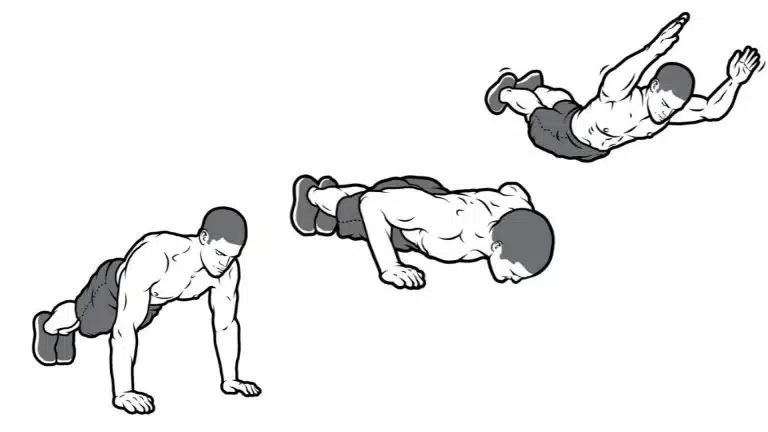
How To Do
- Start in a traditional push up position.
- Now extend your arms out in front of you and your legs should be extended behind you.
- Your fingers are spread out and your core and glutes are tight
- Lower your body down to the ground, keeping your back straight and your core engaged.
- Hold this Superman position for a second or two, then slowly lower your body back to the starting position.
How To Add A Different Type Of Push up To Your Workout?
Push-ups are a versatile exercise. You can do them:
- It also works well as a muscle and strength builder when used separately.
- Mixed into your cardio or strength-training workout.
- At the end of a weightlifting session.
Aim to do pushups 3 to 4 times per week, giving your muscles at least 1 full day of rest between sessions to help them recover.
Proper form is more important than the number of pushups you do. It’s better to do fewer repetitions with good form than more repetitions with poor form.
For a more well-rounded physique, you might consider using various push-ups.
- Push-ups on the wall and knee are the best type of push-ups for beginners.
- Standard push-ups are best for strengthening the chest, shoulders, and triceps.
- Incline Push Up work your lower chest and back more.
- Decline push-up works the upper chest and front shoulders
- Close grip and diamond Push-ups focus more on the tricep and inner chest than the shoulder.
- Wide grip push-ups focus more on the outer chest and shoulder.
- Reverse-type pushups are considered the bicep push-up.
- Pike Push-ups focus more on the shoulder than the chest and tricep.
- The Hindu push-up works your whole body, from your upper to your lower body; it works from your front to your back.
- Single-Leg Push Up, One Arm Push-Up and Clapping Push-Up variations of push-up are best for advanced athletes.
FAQs
Which push-up variation is the best?
The best push-up variation depends on the person’s goals, fitness level, and preferences. There is no one-size-fits-all answer. Different variations target specific muscle groups and offer different levels of difficulty.
Standard push-ups are a great starting point for overall upper body strength, while variations like wide push-ups or decline push-ups target specific muscles more intensely.
What pushups are easiest?
Wall push-ups and knee push-ups are the easiest variations of push-ups to build muscle mass and strength. They reduce the amount of bodyweight you have to lift, making them more manageable for beginners or individuals with limited upper body strength.
Which is the hardest push-up?
Planche push-ups, Superman push-ups, and single-arm push-ups are the hardest variations of push-ups to build muscle mass and strength. These highly demanding and advanced exercises require years of training and practice to achieve.
How long does it take to see results from doing push-ups?
If you do push-ups regularly (2-3 times per week), you can usually see a difference in your strength, muscle tone, and endurance in a few weeks to a few months.
Reference
- Dhahbi W, Chaabene H, Chaouachi A, Padulo J, Behm DG, Cochrane J, Burnett A, Chamari K. Kinetic analysis of push-up exercises: a systematic review with practical recommendations. Sports Biomech. 2022 Jan;21(1):1-40.
- Kim YS, Kim DY, Ha MS. Effect of the push-up exercise at different palmar width on muscle activities. J Phys Ther Sci. 2016 Feb;28(2):446-449. doi: 10.1589/jpts.28.446. Epub 2016 Feb 29.
- Electromyographic comparison of modified push-up exercise

Manish is a NASM-certified fitness and nutrition coach with over 10 years of experience in weight lifting and fat loss fitness coaching. He specializes in gym-based training and has a lot of knowledge about exercise, lifting technique, biomechanics, and more.
Through “Fit Life Regime,” he generously shares the insights he’s gained over a decade in the field. His goal is to equip others with the knowledge to start their own fitness journey.

